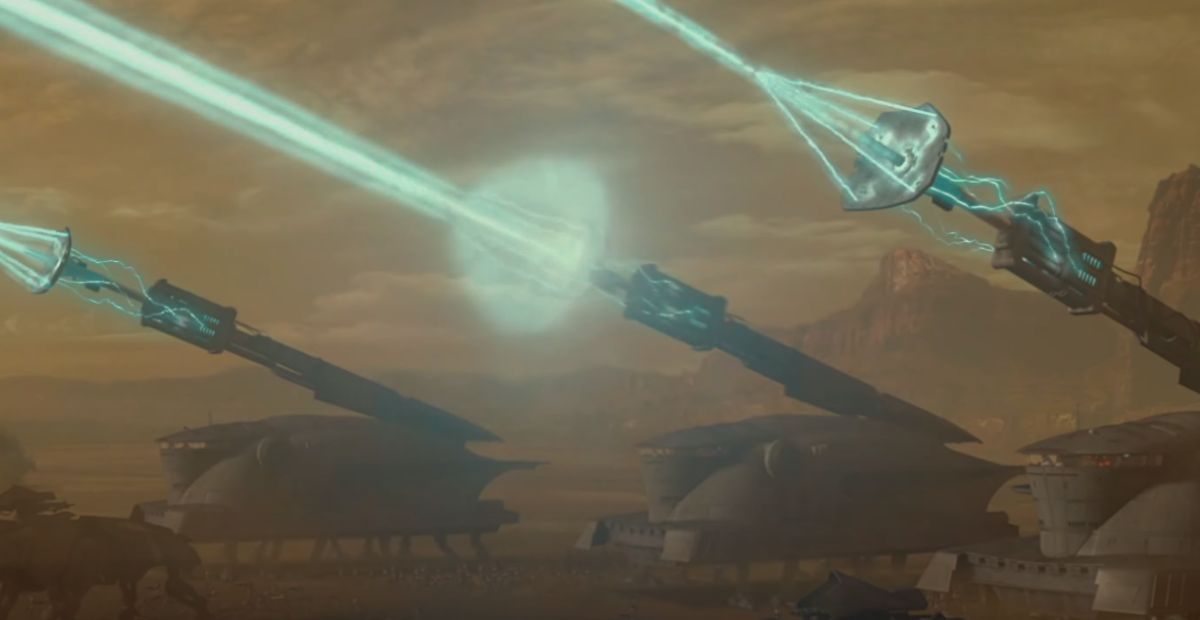During the Clone Wars, the Grand Army of the Republic deployed a unique weapon called the Self-Propelled Heavy Artillery Turbolaser.
It was known for its combination of blasting firepower and mobility. Yet, The Clone Wars series never had a single episode that included them. Why not? Read on to find out more.
What Was the Self-Propelled Heavy Artillery Turbolaser?
The Self-Propelled Heavy Artillery Turbolaser, or SPHA-T for short, was a 12-legged gun platform and the biggest ground-based weapon that the Republic used in the Clone Wars.
Unlike stationary artillery, SPHA-Ts could be easily maneuvered because of their leg ensemble. They had enough versatility that the Empire even adopted these mobile artillery pieces.
SPHA-Ts were 140 meters long and remained in place when firing, but they could use their legs to gain better range on an enemy target.
Their turbolaser was a variant of those used in cannon turrets on Star Destroyers.
The turbolaser was quite powerful but may have had some difficulty with smaller objects. Hence, the mobility angle was necessary for this ground assault weapon.
Despite their size, SPHA-Ts could travel up to 35 kilometers per hour or about 22 miles per hour. These weapons were used in The First Battle of Geonosis in squads of four. They coordinated with infantry to form lines of defense.
In the video above, we can also see a SPHA-T firing on a Separatist Core Ship, demonstrating its destructive power.
As this video explains, the SPHA-Ts were developed to improve on traditional battle techniques and to be “far more bold than anything that had gone before.”
The Republic Army wanted to “strike fast and hard” with low casualties, and the SPHA-Ts were part of this revamped strategy.
With all these advantages, why didn’t we see one in The Clone Wars?
Why Didn’t The Clone Wars Include the Self-Propelled Heavy Artillery Turbolaser?
We may look at the disadvantages of this weapon to explain why it did not appear in The Clone Wars.
The SPHA-T had trouble providing indirect fire, a limited charging capacity, and issues with having enough ammunition.
About 30 clone troopers were also needed to operate these artillery pieces. It could be that the series did not want to include this flawed weapon in the action.
While we did not see this Artillery Turbolaser in The Clone Wars, one fan indicates that we did see Venator ship shoot a laser that was the same.
So, these turbolaser guns were incredibly powerful and better suited for space battles. Another post explains how the SPHA-Ts were probably “phased out after Geonosis” because of their deficiencies, while another states that “these were weird weapons” pointed their beams up as if their lasers would fall back down like traditional artillery. The impracticality of the SPHA-Ts to land battle thus provides an explanation for why they were not used in The Clone Wars.
Even though the show was depicting this era, perhaps the creators did not wish to dwell on a flawed weapon. After all, the SPMAs were replaced by the Self-Propelled Medium Artillery (SPMA) walker. SPMAs had a longer range, a more versatile turbolaser, and were faster than the SPMAs. They also came equipped with 12 light anti-infantry blasters for short-range combat.
This artillery unit resembled the better-known All Terrain Tactical Enforcer (AT-TE), also known as “six legs.” The AT-TE’s walker design and six cannon turrets made it more functional. This video here provides a compilation of how AT-TE’s were used in the series, but, alas, does not include any SPHA-Ts.
No Self-Propelled Heavy Artillery Turbolasers in The Clones Wars
Given its power, the SPHA-Ts did show promise as a ground weapon. They also had some mobility to help with hitting enemy targets. Yet, it seems that their disadvantages outweighed their benefits, and that provides the most likely reason why they were not deployed in The Clone Wars.

